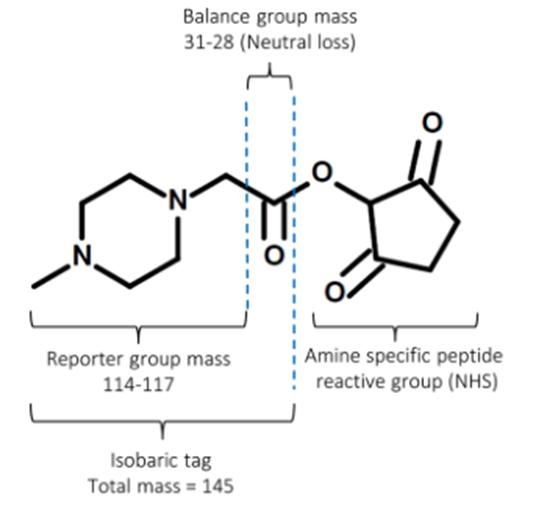iTRAQ-based Quantitative Proteomics Analysis
ITRAQ, or Isobaric Tags for Relative and Absolute Quantitation, has revolutionized quantitative proteomics with its precision and versatility. Creative Proteomics, a seasoned expert in proteomics research, offers professional iTRAQ-based quantitative proteomics services to advance your protein research endeavors.
What is iTRAQ-based Quantitative Proteomics
ITRAQ-based quantitative proteomics, introduced in 2004, is a groundbreaking isotope labeling technology that shares fundamental principles with TMT-based quantitative proteomics. This technique employs isotope tags of equal mass to label the amino groups of peptides, allowing for the simultaneous comparison of protein expression levels across multiple samples. While the iTRAQ method typically offers fewer options than the TMT method (up to eight samples), it also specializes in high-throughput and accurate relative or absolute quantification, and is known for its precision and accuracy. As a result, iTRAQ-based quantitative proteomics has garnered significant attention and widespread application in the field of proteomics. It represents a robust and precise approach to the study of protein expression and dynamics. Its ability to provide comprehensive insights into proteomes has positioned it as an invaluable tool for advancing research in biology, medicine, agriculture, and more.
The Principle of iTRAQ-based Proteomics
ITRAQ tags comprise three essential components: a reporter group, a balance group, and a reactive group. The reactive group forms a covalent bond with the amino group of peptides during labelling. This labelling process ensures that peptides are labeled consistently and uniformly. The balance group serves to offset the mass difference introduced by the reporter group, thereby maintaining equal label weights across different samples. The reporter group, responsible for reflecting the abundance of labeled peptides, enables protein quantification. Peptides from the same protein share identical mass peaks in MS1 after labeling in different samples. Subsequently, in MS2, the balance groups are neutrally lost, releasing the reporter groups and generating reporter ions with distinct masses. By quantifying the abundance of these reporter ions, quantitative information about the same peptide across different samples is obtained. This data can be leveraged to quantify proteins with precision and accuracy.

Fig. 1. Structure of iTRAQ tag. (Rauniyar, N., et al., 2014)
Applications of iTRAQ-based Proteomics
It offers a wide variety of valuable applications. As a result of its efficient and accurate analysis, it is well suited to a wide range of life science fields, such as medicine, biomedicine, agriculture, forestry, animal husbandry, microbiology, and others. Biomarker detection, disease characterisation, pharmacological efficacy, drug development, crop improvement, microbial pathogenesis, and drug resistance research are just a few of the specific applications.
Our Service
ITRAQ-based proteomics stands as a cornerstone technology across various life science disciplines due to its unmatched precision, stability, and exceptional protein coverage. With our commitment to accuracy, stability, and high protein coverage, we enable researchers across diverse life science fields to advance their studies and gain deeper insights into complex biological systems. Creative Proteomics, a trusted leader in the field of proteomics research, is dedicated to delivering high-quality iTRAQ-based quantitative proteomics analysis services to meet the diverse needs of researchers and scientists.

Fig. 2. iTRAQ-based proteomics workflow
Advantages of iTRAQ-based Proteomics
- Labeled in vitro, suitable for a wide range of samples.
- High quantitative stability within the same batch.
- Fast detection and high coverage.
- Integrated with PTMs proteomics to achieve more accurate research on PTMs.
Creative Proteomics provides comprehensive and high-quality proteomics analysis services. If you are interested in iTRAQ-based quantitative proteomics analysis, please contact us for more details.
References
- Rauniyar, N.; Yates, J. R. Isobaric labeling-based relative quantification in shotgun proteomics. Jourmal of Proteome Research. 2014, 13(12): 5293-309
- Aggarwal, S.; Yadav, A. K. Dissecting the iTRAQ Data Analysis. Statistical Analysis in Proteomics. 2016: 277-91

